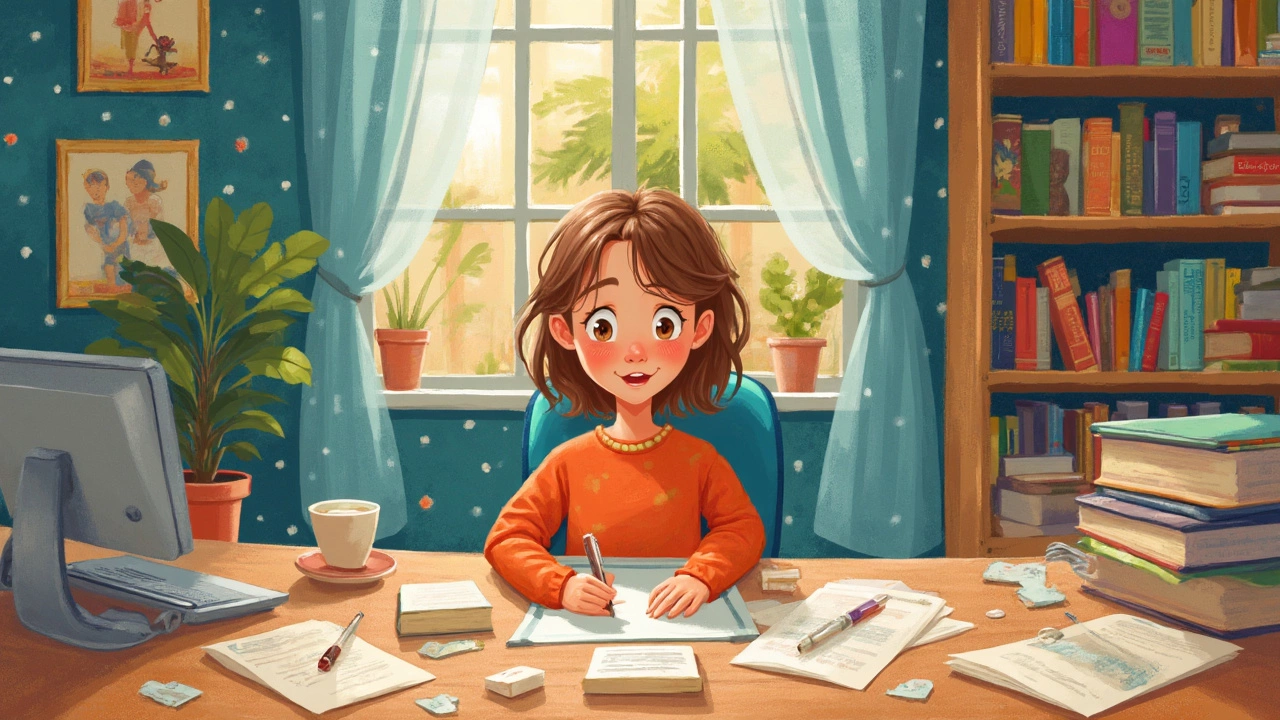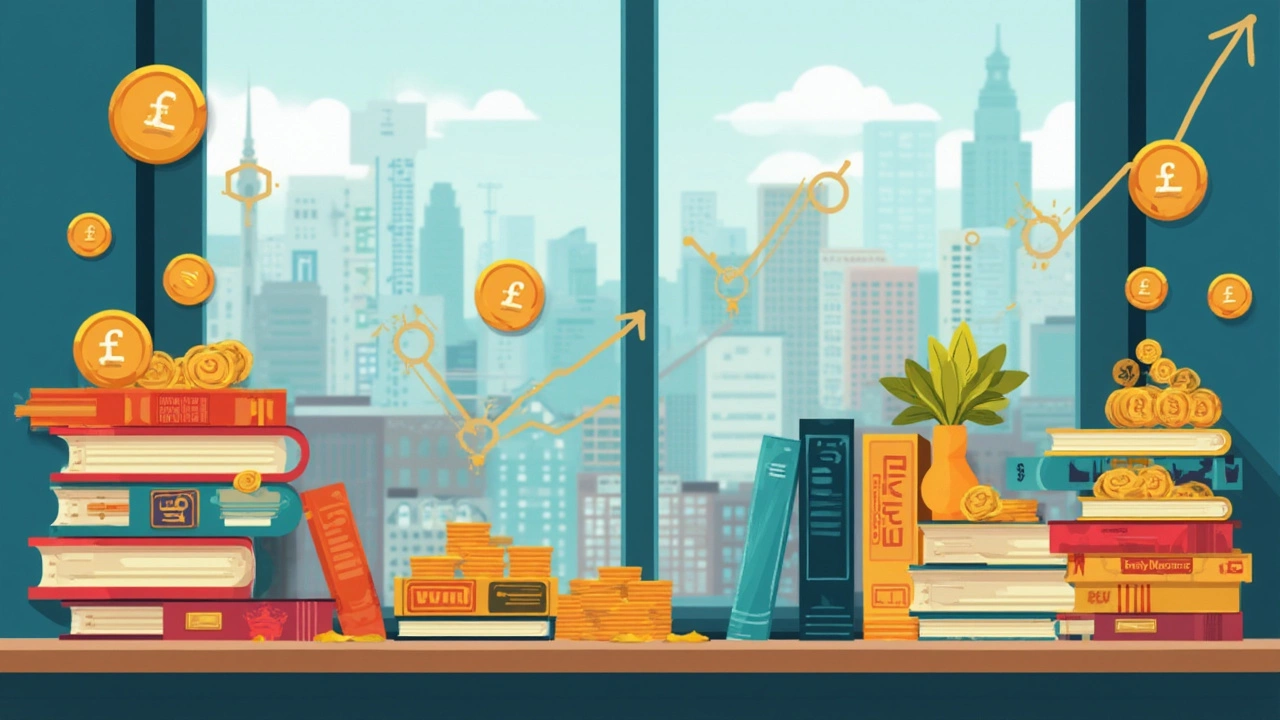How Much Money Do You Make Writing a Children's Book?

Writing a children's book sounds dreamy, but the money part? It’s a lot more complicated than most folks expect. Some people think you write one cute story and suddenly you’re swimming in cash. If only. The truth is, most children’s book authors aren’t quitting their day jobs after book one—not unless lightning really strikes.
If you’re wondering how much money you’ll actually make, start by looking at two things: the advance (that’s the money you get up front if you land a traditional publisher) and royalties (the percentage you get from each book sold). For most first-time authors, advances for a children’s book usually fall between $1,000 and $10,000. Sometimes, you might get more if your book is really in demand, but those cases are rare.
Royalties are where the bulk of long-term income can come from, but here’s the catch: you don’t start collecting royalties until your book sells enough copies to pay back your advance. For a hardcover children’s book, royalties are typically around 10%. So if a book sells for $18, you might see $1.80 per copy—and that’s before agents or taxes take their cut.
- Breaking Down the Money: Advances and Royalties
- Traditional Publishing vs. Self-Publishing
- What Affects Your Take-Home Pay?
- Boosting Your Earnings: Smart Strategies
Breaking Down the Money: Advances and Royalties
When people start talking about writing a children's book, the first question always seems to be, "How big is the advance?" Here’s the scoop: most first-time authors can expect advances between $1,000 and $10,000. Yes, sometimes that number goes higher, especially if you have a big platform or your book creates a buzz. But for most writers, it’s closer to the lower end.
The advance is exactly what it sounds like—a payment made in advance of book sales. It’s not extra money you keep forever. Your book has to sell enough copies to “earn out” this advance before you start seeing any royalties. If you get a $5,000 advance but your royalties only add up to $3,000 after a year or two, you won’t see any new cash until that entire $5,000 is covered by sales.
Royalties come from book sales after the advance is paid back. The rates usually go like this:
- For hardcover children's books: 10% of the list price
- For paperback: 6–8% of the list price
- Ebook royalties: about 25% of the publisher’s net receipts (that’s not the sticker price—it’s what the publisher takes in after discounts)
If you sell your children’s book for $18 as a hardcover, your 10% royalty is $1.80 per book. Paperbacks earning 8% on a $8 book bring you $0.64. Doesn’t sound like much until you start moving thousands of books, right?
Now, here’s the kicker: Most kids book publishing contracts split advances into pieces, so you usually get paid in 2–3 installments—for example, one-third at signing, one-third at manuscript delivery, and one-third at publication. It can stretch out over a year or more, so that big check you dreamed about is more like a slow drip.
| Book Format | Average Advance | Royalty Rate |
|---|---|---|
| Hardcover | $3,000–$8,000 | 10% |
| Paperback | $1,000–$4,000 | 6–8% |
| Ebook | Rarely an advance | 25% (net) |
And don’t forget, if you have an agent, they’ll take about 15% of whatever you make from your children's book earnings. Taxes also come into play. So, whatever you see on a contract? Take a mental slice off for your agent and for Uncle Sam.
Traditional Publishing vs. Self-Publishing
If you want to write a children's book that actually sells, the first thing you need to decide is whether to aim for traditional publishing or go the self-publishing route. Each has its perks, and trust me, the way you get paid is wildly different.
With traditional publishing, you pitch your manuscript to an agent or a publisher. If you strike a deal, you usually get an advance—sometimes $2,500, sometimes $10,000, but rarely more as a newbie. The publisher pays for editing, illustrations, printing, marketing, and distribution. You focus just on writing. Once your book earns back the advance through sales, you get royalties (usually 8–10% of the list price for hardcovers and less for paperbacks).
The big advantage? You don’t spend your own money up front, and you have a team handling the heavy lifting. But you give up a lot of control—publishers call the shots on your story, title, cover, and marketing plan. Also, most publishers only pick a handful of new children’s book authors every year, so competition is fierce.
- Pros: Advance money, professional support, broader bookstore reach
- Cons: Lower royalty rates, slow process (often two years from deal to book), tough to break in
Now, self-publishing is a different world. You’re in charge—editing, illustrations, cover, even getting your kids book onto Amazon or bookstore shelves. The fee for hiring a good illustrator alone can run $1,500–$5,000 per book. But you get to keep a much bigger slice of each sale. With Amazon KDP, for example, you can earn about 60% of the book’s retail price (once printing costs are taken out). For a $10 paperback, you might pocket around $3 per copy. But you only make money if the book actually sells, and every marketing effort falls on your shoulders. You have to hustle.
- Pros: High earnings per sale, total creative control, much faster publishing
- Cons: Upfront costs, all marketing is DIY, tough to get into brick-and-mortar bookstores
| Publishing Path | Advance | Typical Royalty Rate | Time to Publish |
|---|---|---|---|
| Traditional | $1,000-$10,000 | 8-10% | 12-24 months |
| Self-Publishing | None | ~60% (after costs) | 1-3 months |
If you like having all the say and don’t mind hustling for sales, self-publishing might be your thing. If you’d rather just write and let the pros do the rest, aim for traditional publishing. Don’t let anyone tell you there’s only one right way to do it—authors earn real money both ways, but the routes look totally different.

What Affects Your Take-Home Pay?
Your total income from writing a children's book depends on way more than your story and a burst of inspiration. The money side actually comes from a mix of factors, and these can make a huge difference in your bank account.
First, your publishing path is huge. If you choose traditional publishing, you'll probably get an advance, but you might need to split it with an agent if you have one. Self-publishing skips the advance but gives you a much bigger cut of each sale. For context, self-published authors on Amazon usually keep about 60-70% of their book's price, while with a traditional publisher, your royalty might stick around 10%.
Next up: category and length. Board books, picture books, chapter books—they all come with different price tags and royalty setups. Picture books, for example, often have lower royalties because you split them with your illustrator unless you're both the writer and artist.
- Book format: Paperbacks, hardcovers, and ebooks all pay different royalty rates. ebooks often give you a bigger chunk—sometimes up to 70% if you’re self-publishing through Kindle Direct Publishing, for instance.
- Illustrators: In kids' books, illustrators usually get half the royalties, especially for picture books.
- Agent fees: Agents commonly take 15% of your advance and royalties, which chips away at your profits but can mean better contracts or bigger deals long term.
- Sales volume: Honestly, the biggest factor is how many copies your kids book sells. Most children’s books sell fewer than 3,000 copies over their lifetime. It’s rare to hit bestseller status, where the real money kicks in.
Check out a quick snapshot of how the numbers play out:
| Factor | Typical Impact on Earnings |
|---|---|
| Advance Amount | $1,000 - $10,000 (one-time up front) |
| Traditional Royalties | 5% - 10% per print copy |
| Self-Publishing Royalties | 60% - 70% per sale |
| Agent Fee | 15% cut of advance & royalties |
| Illustrator Split | Usually 50% of royalties for picture books |
So, your real take-home pay on your children's book earnings can swing wildly based on these details. Don’t forget, you’ll also pay taxes on the money you make. Keeping these things in mind will help you get a better picture of what you might actually earn if your kids’ book hits the shelves.
Boosting Your Earnings: Smart Strategies
If you want to make real money from your children's book earnings, you need a plan that goes beyond just writing. The sad news is, most books don’t hit the bestseller list automatically. To see anything decent in your bank account, you’ll need to get creative with selling and promoting your work.
First, don’t just rely on your publishing house to market your book. Even with traditional publishers, most of the promotion work lands on the author. Build up your own audience—start with a simple website and be active on social media channels where parents and teachers hang out. Don’t underestimate school visits and library readings; they can spike your book sales and open doors for more opportunities.
- Reach out to local bookstores and set up readings or signings. Kids (and their parents) are more likely to buy after meeting you in person.
- Connect with teachers by offering classroom activities or downloadable lesson plans based on your book. Lots of educators love new content to use in their classrooms.
- Send out free review copies to parenting bloggers and educational influencers—they can spread the word faster than you can.
Thinking about self-publishing? This path can be profitable, but you need to treat it like a business. Good cover design and editing are non-negotiable—books that look homemade don’t sell. Invest in these services if you’re serious about being seen.
Also, don’t forget about formats. Offer your book as a hardcover, paperback, eBook, and even an audiobook. A 2024 Author Earnings report showed that eBooks and audiobooks made up about 35% of total kids’ book revenue on Amazon, so you’re missing out if you skip them.
| Format | Potential Earning (per copy) |
|---|---|
| Hardcover | $1.50 - $2.00 |
| Paperback | $0.80 - $1.20 |
| eBook | $2.00 - $4.00 |
| Audiobook | $1.50 - $3.00 |
If you’ve already got one book out there, don’t stop—series tend to sell better than standalones. Parents who like your first book will come back for more if you keep the story going. And honestly, nothing beats word of mouth. Ask readers for reviews, share reader photos (with permission), and keep that community vibe strong. Small moves, but they can make your kids book publishing journey way more profitable.
